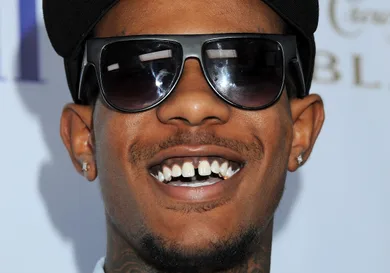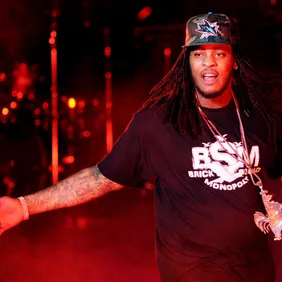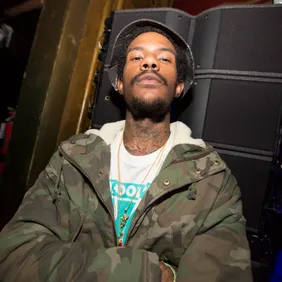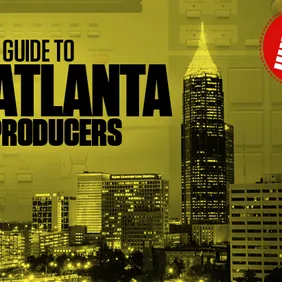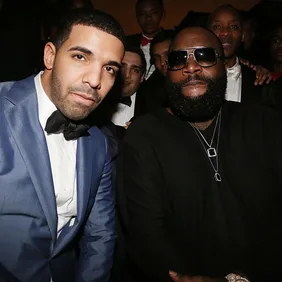Though he built much of his reputation in Atlanta, Lex Luger hails from Suffolk, Virginia and now resides in the neighboring town of Chesapeake. His career took off shortly after he got serious about music. He dropped out of high school after 10th grade to devote all his time to churning out menacing trap beats. “Nothing but time to practice all day,” he says of learning his craft in a town without a mall or a movie theater. Little did he know that he’d be one of the most recognizable producers in hip-hop by the time he was 19.
Luger began to dramatically increase his output after his friend and collaborator Ur Boy Black let him try out a pirated copy of Fruity Loops. With the software, he found that he could knock out at least 10 beats a day. This was when rap artists were just beginning to master the Internet as a platform for self-marketing. When he was 18, Luger used MySpace to connect with a barely buzzing Atlanta rapper named Waka Flocka Flame who had just found a mentor in Gucci Mane.
He sent Waka 40 beats, landing three on 2009’s Salute Me or Shoot Me 2, including an early version of “Hard in da Paint” (then titled “Hard”), which would eventually become the game-changing single that helped Waka become the new face of trap with his debut album, Flockaveli, released in late 2010.
When he first heard “Hard in da Paint” on the radio, Luger had barely cut a check with his beats. “I was at a dark point,” he says -- dead broke, out of school, and with a second child on the way. He felt the streets looming right outside of his basement studio, and he was able to channel both the fear and appeal of that world into his music.
The all-encompassing menace of “Hard in da Paint” is what made it stand out from the crunk/trap hybrid that had been brewing in Atlanta for a few years. “Music became more dark,” says Luger. “We took it back to the streets, the trap -- the taboo of black culture, I wanna say. It’s just bringing the gutter-ness back. Kind of how Mobb Deep did for New York.”
And where Havoc used rugged snares, and bleak piano loops -- all smeared in a vinyl static that evokes urban decay, Luger took an opposite approach. Inspired by early Three 6 Mafia as well as film scores like Hans Zimmer’s for “The Dark Knight,” he created grandiose arrangements that didn’t use shadowy suspense to hint at danger but, instead, embraced that evil with the sounds of cataclysmic warfare.
As for Waka, he certainly lacked a sense of careful detail, though he had what trap music had been calling for: unadulterated rage. Indeed, he proved to be one of the few voices who could stand up to Luger’s larger-than-life productions.
From Waka to Rozay to Watch the Throne
Bellowing lines like “When my brother died, I said ‘Fuck school’,” Waka seemed to provide a convincing portrait of the Atlanta streets, but what made the music so popular was its fantastical appeal -- so immediately eye-opening that it verged on escapism.
Just as “Hard in da Paint” was beginning to take off, Luger got a call from Rick Ross, who wanted to up his street presence with his Albert Anastasia EP before the release of July 2010’s Teflon Don. Ross chose two of the hardest, loudest beats of the 40 or so that Luger had sent him, and the two songs he came up with, “MC Hammer” and “Blowin’ Money Fast,” showed up consecutively on both the EP and the album.
Rozay compared himself to storied drug dealers on one track and to a rapper whose wasteful spending led to his demise on the other. Ross is nothing if not one of rap’s most brilliant actors, and with the help of Luger’s climactic trap symphonies, he took on a persona that was only fit for the big screen. The sheer recklessness of it all was refreshing, and listeners had little time to question Ross’ kingpin boasts as they were force-fed over a constant blast of palpitating 808s.
After giving Rick Ross one of the biggest hits of his career with “B.M.F.,” the rest of the industry came calling. While he was still 19, Luger was sought out by a man who had already achieved Throne-worthy status. “I didn’t know who the hell it was at first,” says Lex of his surprise call from Kanye West. “He didn’t introduce himself. He just called me, and he just started talking about music.” “When can I fly you out to New York,” asked Kanye soon after Luger had realized whom he was talking to.
Days later, Luger met Kanye, Jay Z, and Beyonce at Jimi Hendrix’s Electric Lady Studios in Manhattan. Kanye first put Lex in his own studio and told him to add some drums on the track that would become “See Me Now,” a MBDTF bonus cut featuring Beyonce and Big Sean. He laid down a similar but more organic-sounding hi-hat rollout to that of “B.M.F.” as well as a tightened snare breakdown that proved complementary to the Charlie Wilson vocal melody that drives the song. "See Me Now" is both evidence of Luger’s more joyful side as well as the imminent discovery that trap drums can work on just about any type of production.
He then played Kanye and Hov some of his own work, including the beat that would eventually become the lead single to their joint album, Watch the Throne. “And he [Kanye] just heard that [‘H.A.M.’], and I guess it was so monstrous, and it sounded so epic, know what I mean. And he added the fuckin’ choir, it was just crazy.”
Aside from “Hard in da Paint,” “H.A.M” is Luger’s most recognizable beat, with a dizzying synth line taken out of a ‘90s techno rave combined with some of his slickest and fastest-ever drum work. It’s hard to imagine a beat that better matches the size of The Throne’s consummate ego, and “H.A.M.” was about as loud a statement as two veterans could make in a changing landscape where attitude was everything. After months of waiting, Luger finally heard “H.A.M.” when it premiered in January of 2011.
Last year it was Metro Boomin -- and DJ Mustard the year before that. In 2011, the most in-demand producer was undoubtedly Lex Luger. After “H.A.M.,” Luger scored singles for Ace Hood, Snoop Dogg, and Wale, and he enjoyed more placements from his reliable partners Waka Flocka and Rick Ross.
To the surprise of much of the rap world, after “Round of Applause,” the Drake-featuring single that would land on Waka’s 2012 album Triple F Life, Luger wouldn’t score another single for over three years. That track was an indication that Luger was beginning to explore emotions other than aggression and that he was enhancing his focus on melodies both softer and slower. Everyone still wanted his signature sound, but it was a demand he was less willing to supply.
Scroll through the galleries to go Behind the Beat with Lex Luger
Expanding His Sound + New Singles for Wiz Khalifa & A$AP Ferg
Luger didn’t just disappear for a few years. He actively rescinded the spotlight, moved back to his small-town stomping grounds, and became a better father to his two daughters. There was certainly some exhaustion, but, by any standard, he remained prolific. If one looks at his storied 2011, it’s his mixtape credits that are actually more impressive than his album placements. In addition to more work with Ross and Waka, he gave beats to 2 Chainz and French Montana, and he helped welcome Wiz Khalifa to the trap world with Cabin Fever. He also joined one of his foremost idols, Juicy J, for a total of three joint tapes.
He’s continued to produce for rappers in all lanes, from Big Sean to The Game and Future to Mac Miller. He also started his own production company, TMOG, which includes rising talents like Deedotwill, and reinvested his efforts in his hometown group, VABP (Virginia Boyz Production), in which he both raps and produces.
A moment that has proven to be a major turning point in Luger’s career was when he met electronic producer, DJ, and label boss A-Trak. He was surprised to hear from A-Trak that his music was especially popular with EDM DJs. “You could really make a killing out here mixing trap with EDM,” A-Trak told him.
Unintentionally, the maximalist rage of Luger’s sound led trap to become a subgenre of EDM. And more often than not, the most sensational parts of Luger’s trap kit were melded into ravey anthems with little respect for the actual inspiration behind the music. Luger and A-Trak sought to correct this oversight by making a project that combined the griminess of trap with the synthetic adrenaline of EDM.
On their joint Low Pros EP, released in May 2014, they recruited the then-burgeoning talents of Young Thug, Travis Scott, and PeeWee Longway for a rare showcase of careful genre-mixing. Indeed, it is the capacity of both Scott and Thug to gravitate toward trap’s more experimental side that has resulted in their current stardom. “It took my music to the next level,” says Luger of his partnership with A-Trak, with whom he’s currently prepping a sequel EP.
To give a taste of what his beats can do when they’re not dictated by major emcees, Luger recently put out his first instrumental album: The Lex Luger Experience Vol. 1. It plays out like a live DJ set, with nods to Luger’s past hits as well as to the new territory he’s currently exploring.
This year, Luger is already back to getting his single money, having contributed to Wiz Khalifa and Travis Scott’s “Bake Sale” as well as producing A$AP Ferg’s Always Strive and Prosper standout “Let It Bang,” featuring Schoolboy Q. Both tracks are worlds away from the placements by which he first came to fame, and both are evidence of his continued ability to reinvent his sound, which will likely keep his name around for years into the future. Amazingly, he’s only 25 years old.
“I wanna be everywhere, man,” Luger says of his future goals, “Because if this fails, or this trend goes out, I could fall back on this, know what I mean. Cause shit changes up daily, man. It’s crazy nowadays.”
